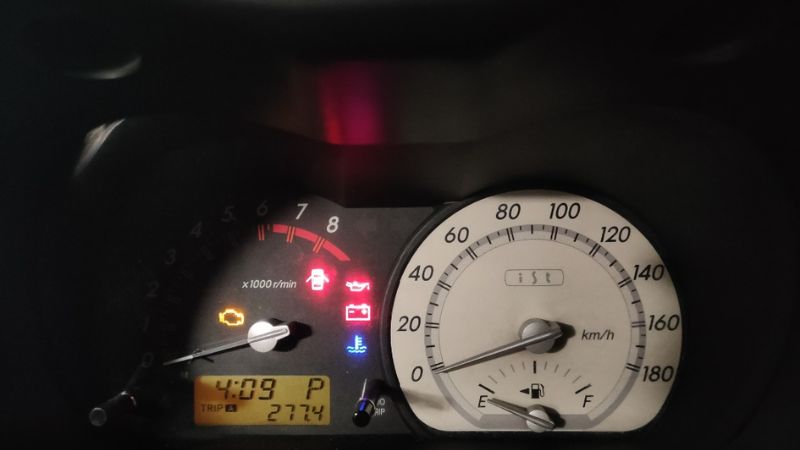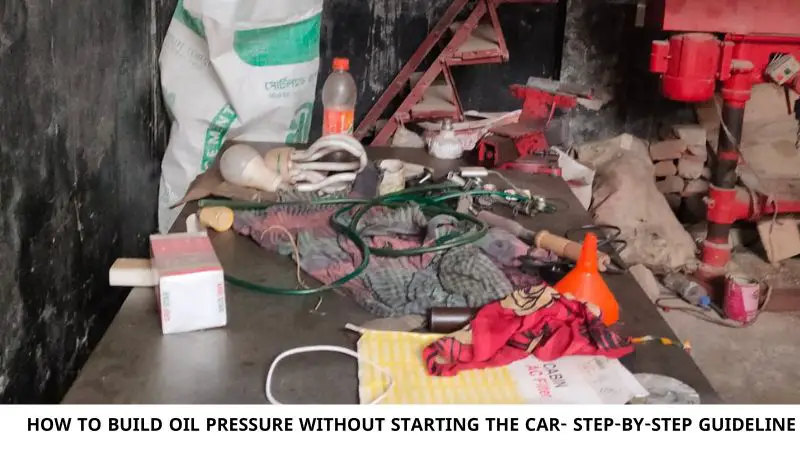Before starting your car, priming the engine oil is an essential task. This will help ensure that the oil is properly distributed throughout the engine and help protect the engine from wear.
But in this case, the question may come, how to build oil pressure without starting a car?
There are a few ways to build up oil pressure without starting the car. The simplest way is to crank the engine by hand. It can be done by disconnecting the battery, removing the spark plugs, and using a socket and ratchet to turn the crankshaft. Another way is to use an air compressor to create pressure in the oil system.

All it takes is a little patience and know-how to outsmart a low-oil-pressure situation. Keep reading to learn how to prime the engine before starting so you can get back on the road as quickly as possible.
What Causes No Oil Pressure at Startup
When you turn the key and your oil light stays on, it usually means there’s no oil pressure building up. It is not good for your engine and needs to be addressed quickly.
The most common causes of no oil pressure at startup are:
Low oil level
If your oil level is low, the oil pump won’t have enough oil to pump through the engine. Check your dipstick and add oil if it’s below the “add” mark.
Faulty oil pump
The oil pump is responsible for generating oil pressure. If it’s damaged or failing, it won’t be able to pump oil efficiently. You may need to replace the oil pump.
The blocked oil pickup tube
The oil pickup tube pulls oil from the oil pan to the oil pump. If it’s clogged, oil can’t get to the pump. Drop the oil pan to clean or replace the pickup tube.
Stuck pressure relief valve
The relief valve opens to release excess pressure. If stuck open, it won’t allow pressure to build up. The valve will need to be replaced.
Damaged sensor
The oil pressure sensor monitors pressure and triggers the warning light. A faulty sensor could turn the light on even with normal pressure. Have the sensor tested and replaced if needed.
Be very careful when working around moving engine parts. Oil and tools can also be slippery, so take your time and exercise caution.
If at any point you don’t feel comfortable doing this yourself, have the vehicle towed to a mechanic.
How Long Does It Take for a Car to Build Oil Pressure?
It’s a very common question for many car owners. The short answer is it usually takes 20 minutes after the engine startup.
But there are a few factors that determine the exact time.
The oil pump
The oil pump is responsible for pumping oil through your engine to build pressure. If there’s an issue with your oil pump, it will take longer to build pressure – if it builds at all.
Oil viscosity
Thicker, higher-viscosity oils take longer to flow through the engine than thinner, lower-viscosity oils. So if it’s especially cold outside, it may take a bit longer for your oil to build pressure.
Engine temperature
Colder engines require more time for the oil to circulate and build pressure. As the engine warms up, the oil also warms and flows more easily.
Oil level
If your oil level is low, the oil pump has less oil to circulate, so it will take longer to build pressure. Check your oil level regularly and refill as needed.
It’s a good idea to check your oil pressure gauge regularly when driving to make sure pressure is within the normal range for your vehicle make and model.
Low or no oil pressure is a serious issue, so if the gauge is reading low, pull over and shut off the engine immediately to avoid permanent damage. Your engine’s health depends on it.
Check Also: Low Oil Pressure at Idle: Causes & Repair process
How to Build Oil Pressure Without Starting the Car
To build oil pressure without starting your engine, you’ll need to manually prime the oil pump and lubricate the engine.
It is necessary if you’ve performed any repairs that drained the oil, like an oil change or oil pan gasket replacement.
Priming the pump will ensure your engine has oil pressure as soon as you start it, preventing damage.

Gather the Necessary Supplies
You’ll need a few basic tools and supplies:
- An engine oil priming tool or oil pump primer, which attaches to your oil pump and allows you to manually spin it. You can find these at most auto parts stores.
- A cordless drill or impact wrench to spin the priming tool.
- Fresh motor oil in the correct weight and capacity for your vehicle’s engine.
- Oil filter, if you’ve also replaced the filter.
- Funnel to pour the new oil into the engine.
- Rags, in case of any spills.
Access the Oil Pump
Locate your oil pump. It’s usually at the bottom of the engine block. You may need to remove a cover or the oil pan to access it. Consult your vehicle’s service manual for the exact location and any parts you’ll need to remove.
Attach the Priming Tool and Spin
Attach your priming tool to the oil pump driveshaft or gear. Place the drill on the priming tool and spin it in the direction of normal engine rotation. Spin the pump for 30 to 60 seconds to fully prime it and build oil pressure.
Add Fresh Oil and Filter
Remove the priming tool and reinstall any parts you removed to access the oil pump. Pour in the fresh oil through the filler hole or cap on your engine using the funnel. Also, replace the oil filter if needed.
With the oil pump primed and fresh oil added, your engine will have oil pressure as soon as you start it. Double-check that the drain plug, filter, and any other removed parts have been properly reinstalled before starting the engine.
Crank the engine for a few seconds, shut it off, and recheck for leaks. If everything looks good, start the engine and you’re ready to drive your car.
Safety Precautions to Take Before Building Oil Pressure
Before you start building oil pressure in your vehicle, there are a few safety precautions you should take. Your safety should be the top priority here.
Turn Off the Ignition
Make sure the ignition is turned completely off. It means removing the keys from the ignition to avoid accidentally starting the engine. With the ignition off, the engine cannot start, even if the starter is engaged.
Disconnect the Battery
Disconnect the negative battery cable from the negative battery terminal. It will cut all electrical power to the vehicle and ensure the engine does not accidentally start. Be very careful when disconnecting the battery, as the connections can spark.
Allow Parts to Cool
If the engine was recently running, allow adequate time for all engine parts like the oil pan, valve covers, and exhaust manifolds to cool completely. Hot engine parts can cause severe burns, so safety gloves and protective eyewear should be worn.
Jack Up the Vehicle
For access to some oil pressure-sending units or oil pumps, it may be necessary to jack up the vehicle and support it with jack stands. Never work under an unsupported vehicle.
Jack stands to provide a stable base to support the weight of the vehicle. Wheel chocks can also be placed in front of and behind the front tires as an extra precaution.
Use Protective Equipment
Wear safety goggles, work gloves, and protective clothing like coveralls when working around engine parts. Oil, grime, and sharp metal edges can cause injury. Be very careful when handling tools and engine components.
Following these safety steps will help ensure you avoid injury and prevent accidental engine start-up when building oil pressure.
Final Thought
So, you already got an idea of how to build oil pressure without starting car. Yes, it may seem complicated. But if you follow the instructions carefully and take proper safety precautions, you’ll be able to get the oil circulating in no time.
Remember, having good oil pressure is essential for the health and performance of your engine, so don’t skip this important step.
Once you’ve built up pressure, you can start that engine with confidence knowing you’ve given it the care and maintenance it deserves. Thank you all for reading this article.
